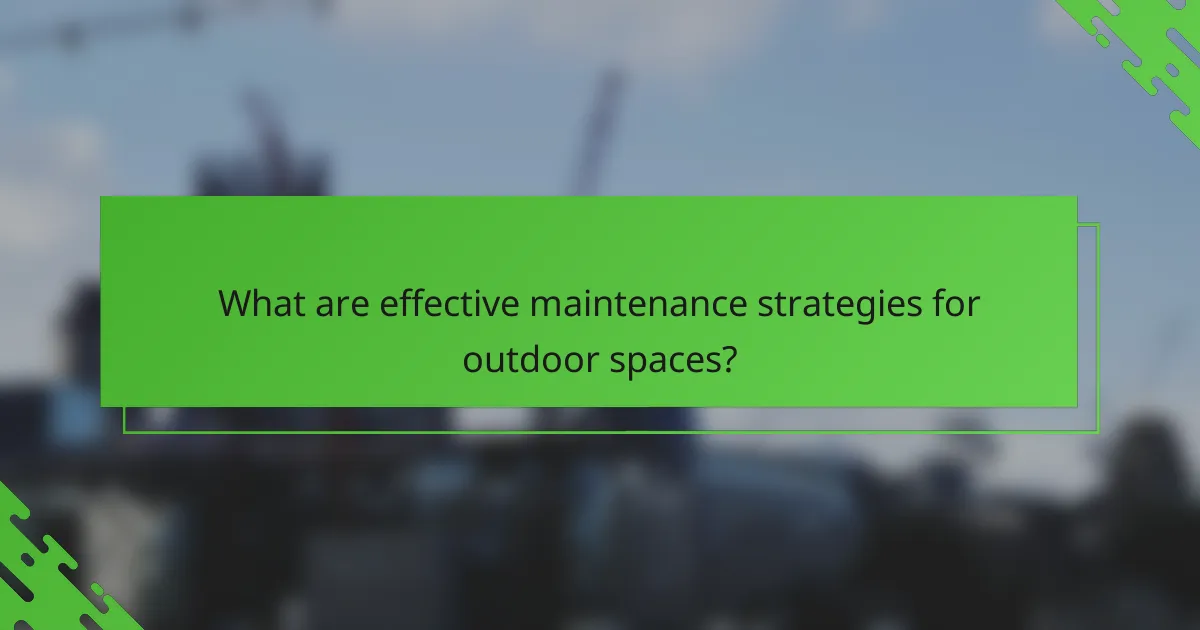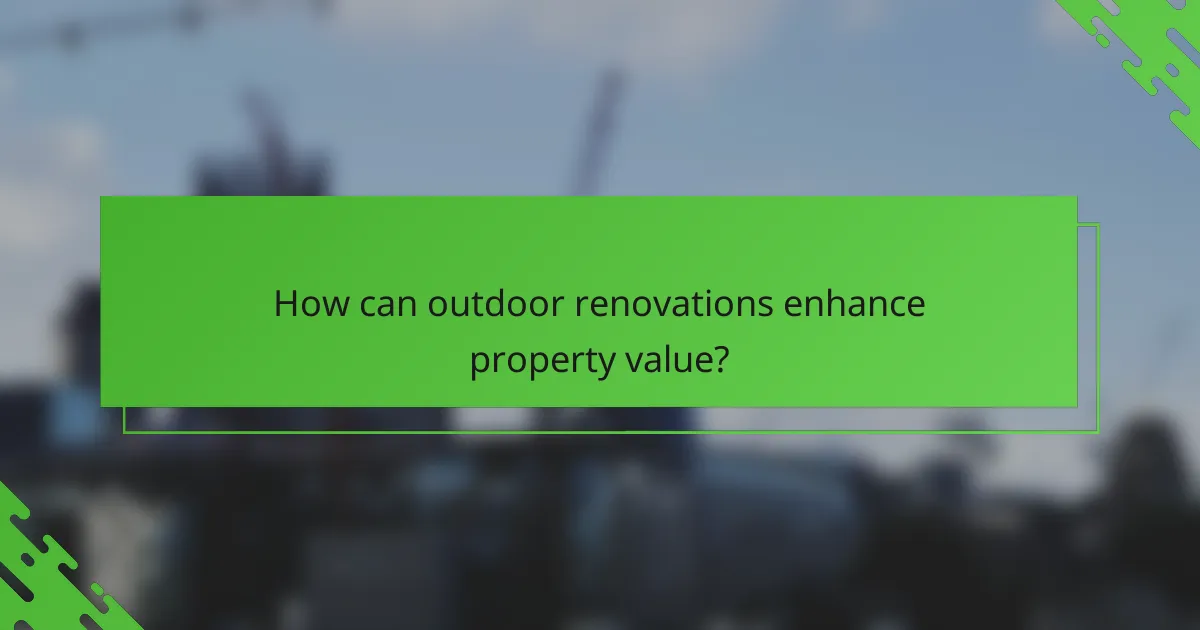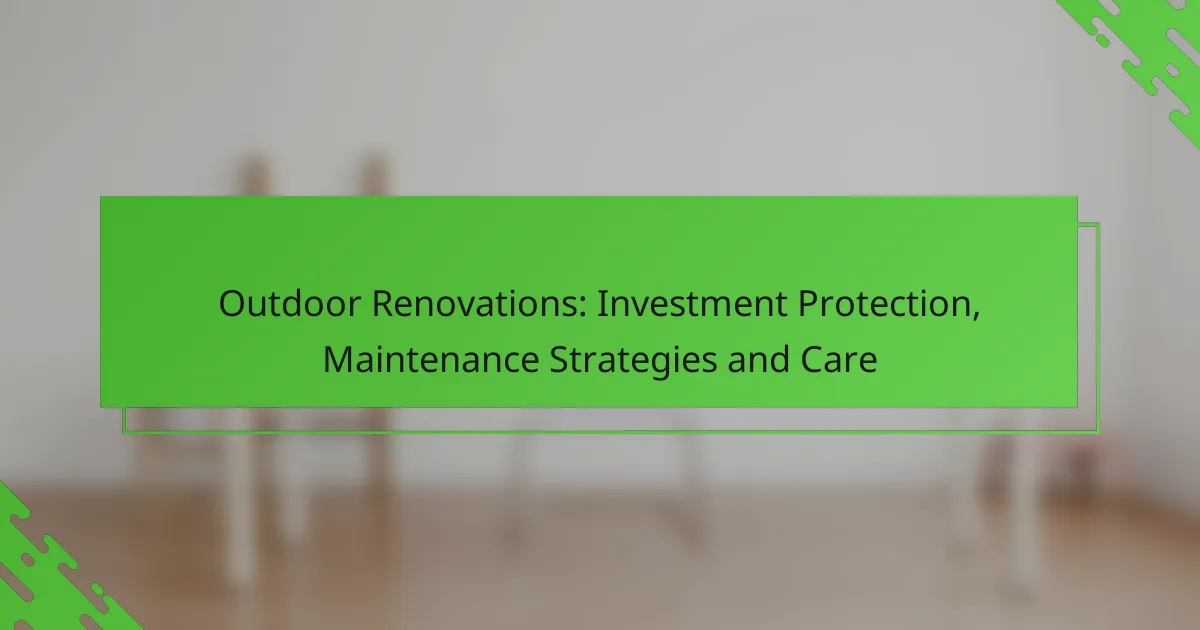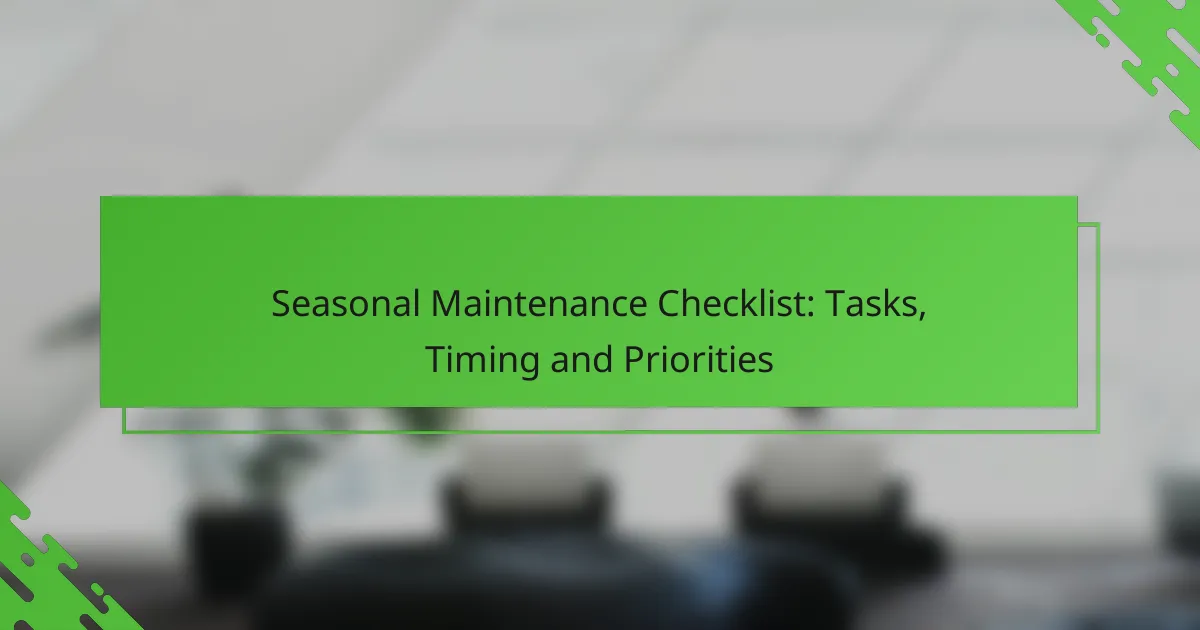Investing in outdoor renovations can significantly enhance your property’s value, but protecting that investment requires careful consideration of materials and maintenance strategies. By choosing durable materials and implementing regular upkeep, you can ensure your outdoor spaces withstand the elements and retain their aesthetic appeal. Proactive care, including proper drainage systems, is essential to prevent damage and prolong the lifespan of your renovations.

What are the best outdoor renovation solutions for investment protection?
To protect your investment in outdoor renovations, focus on high-quality materials and systems that withstand the elements. Prioritizing durability and low maintenance can significantly enhance the longevity and value of your property.
High-quality decking materials
Choosing high-quality decking materials is crucial for ensuring the longevity of your outdoor spaces. Options like composite decking, which combines wood fibers and plastic, offer resistance to fading, staining, and moisture, making them ideal for various climates.
When selecting decking, consider materials that come with warranties of 25 years or more. This not only protects your investment but also minimizes future maintenance costs. Avoid untreated wood, as it can warp and rot over time.
Durable siding options
Durable siding options can significantly enhance the protection of your home’s exterior while improving its aesthetic appeal. Fiber cement siding is a popular choice due to its resistance to pests, fire, and harsh weather conditions, often lasting over 50 years with minimal upkeep.
Vinyl siding is another viable option, providing a cost-effective solution that requires little maintenance and comes in various colors. Ensure that any siding you choose meets local building codes and energy efficiency standards to maximize your investment.
Weather-resistant roofing systems
Investing in weather-resistant roofing systems is essential for safeguarding your home against the elements. Materials like metal roofing and asphalt shingles with high wind ratings can withstand severe weather, extending the lifespan of your roof significantly.
Consider roofs that come with warranties of 30 years or more and are designed to reflect heat, which can lower cooling costs. Regular inspections and maintenance are crucial to identify potential issues early and prolong the life of your roofing system.

How to maintain outdoor renovations in urban areas?
Maintaining outdoor renovations in urban areas requires regular attention to ensure longevity and aesthetic appeal. Factors such as pollution, weather variations, and high foot traffic can accelerate wear and tear, making proactive care essential.
Regular inspections and repairs
Conducting regular inspections of outdoor renovations is crucial for identifying issues early. Look for signs of damage such as cracks in pavement, rust on metal fixtures, or deterioration of wood surfaces. Aim to perform these checks at least twice a year, ideally in spring and fall.
When repairs are necessary, prioritize using materials that are suitable for urban environments. For instance, choose weather-resistant paints and sealants to protect surfaces from moisture and pollution. Keep a checklist of common problem areas to streamline your inspections.
Seasonal cleaning strategies
Implementing seasonal cleaning strategies helps maintain the appearance and functionality of outdoor spaces. In spring, focus on removing debris, cleaning surfaces, and checking drainage systems to prevent water accumulation. In winter, ensure pathways and entrances are clear of snow and ice to avoid accidents.
Consider using eco-friendly cleaning products to minimize environmental impact, especially in urban settings where runoff can affect local waterways. A simple cleaning schedule can include tasks like power washing hardscapes and treating wooden structures with protective oils or stains.

What are effective maintenance strategies for outdoor spaces?
Effective maintenance strategies for outdoor spaces include regular upkeep and proper drainage systems. These practices not only enhance the aesthetic appeal but also protect your investment by preventing damage and prolonging the lifespan of your outdoor features.
Routine landscaping upkeep
Routine landscaping upkeep involves regular tasks such as mowing, trimming, and weeding to maintain the health and appearance of your outdoor areas. Aim to mow your lawn weekly during the growing season and trim shrubs and trees as needed to prevent overgrowth.
Additionally, consider seasonal tasks like mulching in the spring and fall to retain moisture and suppress weeds. Regularly check for pests and diseases, and address any issues promptly to avoid larger problems.
Proper drainage systems
Proper drainage systems are crucial for preventing water accumulation, which can damage plants and hardscapes. Ensure that your outdoor space has adequate grading to direct water away from structures and consider installing French drains or dry wells in areas prone to pooling.
Regularly inspect and clean gutters and downspouts to ensure they function correctly. It’s also wise to check for any blockages in drainage systems after heavy rainfall to maintain optimal water flow.

How does climate affect outdoor renovation care?
Climate significantly influences the care required for outdoor renovations, affecting the longevity and performance of materials. Factors such as humidity and temperature fluctuations can lead to wear and tear, necessitating tailored maintenance strategies to protect your investment.
Impact of humidity on materials
Humidity levels can cause various materials to expand or contract, leading to structural issues or surface damage. For instance, wood may swell in high humidity, resulting in warping or cracking, while metal components can suffer from rust if not adequately protected.
To mitigate humidity’s effects, consider using moisture-resistant materials for outdoor renovations. Regular inspections and maintenance, such as sealing wooden surfaces and applying rust inhibitors to metal, can help prolong the lifespan of your outdoor features.
Temperature fluctuations and maintenance
Temperature changes can lead to significant stress on outdoor materials, especially those that are not designed to withstand extreme conditions. For example, concrete can crack in freezing temperatures, while certain plastics may become brittle in intense heat.
To manage the impact of temperature fluctuations, choose materials that are rated for your local climate. Regular maintenance checks during seasonal transitions can help identify potential issues early, allowing for timely repairs and adjustments to protect your renovations.

What are the costs associated with outdoor renovations?
The costs of outdoor renovations can vary significantly based on the scope of the project, materials used, and labor involved. Homeowners should budget for both installation and ongoing maintenance to ensure their investments are protected over time.
Average pricing for decking installation
The average cost for decking installation typically ranges from $15 to $35 per square foot, depending on the materials chosen. Composite decking tends to be on the higher end of this range, while pressure-treated wood is generally more affordable.
When planning a decking project, consider additional expenses such as permits, design fees, and potential site preparation. It’s wise to obtain multiple quotes from contractors to ensure competitive pricing and quality workmanship.
Cost breakdown for landscaping services
Landscaping services can vary widely, with average costs ranging from $50 to $150 per hour for labor, depending on the complexity of the work and the region. Basic services like lawn care or planting can cost a few hundred dollars, while more elaborate designs may run into the thousands.
Key factors influencing landscaping costs include the size of the area, types of plants and materials selected, and any hardscaping features like patios or walkways. Homeowners should prioritize their needs and seek detailed estimates to manage their budgets effectively.

What are the key factors in choosing outdoor renovation materials?
When selecting outdoor renovation materials, consider factors such as durability, environmental impact, maintenance needs, and aesthetic appeal. These elements will significantly influence the longevity and performance of your renovations.
Longevity and durability
Longevity and durability are critical when choosing materials for outdoor renovations. Opt for materials like composite decking, natural stone, or treated wood, which can withstand various weather conditions and resist wear over time. Generally, high-quality materials can last several decades with proper care.
Evaluate the expected lifespan of materials based on local climate conditions. For instance, in areas with heavy rainfall, materials that resist moisture damage, such as vinyl or fiber-cement siding, may be preferable. Always check warranties, as they can provide insight into a material’s durability.
Environmental impact considerations
Environmental impact is an essential factor in selecting outdoor renovation materials. Choose sustainable options like reclaimed wood, bamboo, or recycled materials, which minimize resource depletion and reduce carbon footprints. These materials often have lower environmental impacts compared to traditional options.
Research local regulations or certifications, such as LEED or Green Seal, which can guide you towards eco-friendly choices. Additionally, consider the lifecycle of materials, including their production, transportation, and disposal, to ensure a comprehensive understanding of their environmental effects.

How can outdoor renovations enhance property value?
Outdoor renovations can significantly increase property value by improving curb appeal and expanding usable living space. Enhancements such as landscaping, patios, and outdoor kitchens not only attract potential buyers but also create a more enjoyable environment for current homeowners.
Investment protection through outdoor renovations
Investing in outdoor renovations helps protect your property value by maintaining and enhancing its exterior condition. Well-planned improvements can prevent deterioration and reduce long-term maintenance costs. For instance, adding a quality deck can extend the life of your home’s structure by providing a functional outdoor space that keeps visitors off the grass and away from the foundation.
Consider focusing on high-return projects such as landscaping, which can yield returns of around 100% or more, or adding a fence that provides both privacy and security. Always prioritize renovations that align with neighborhood standards to ensure your investment remains competitive.
Maintenance strategies for outdoor spaces
Regular maintenance is crucial for preserving the value of outdoor renovations. This includes routine tasks like cleaning gutters, sealing decks, and maintaining landscaping. Establishing a seasonal maintenance schedule can help keep outdoor areas in top condition and prevent costly repairs.
For example, pressure washing patios and walkways annually can prevent mold and dirt buildup, while mulching flower beds can reduce weed growth and retain soil moisture. Always use high-quality materials that withstand local weather conditions to minimize future maintenance needs.
Care tips for outdoor renovations
Caring for outdoor renovations involves both proactive and reactive measures. Regular inspections can identify issues early, such as cracks in concrete or signs of rot in wooden structures. Addressing these problems promptly can prevent more extensive damage and maintain the aesthetic appeal of your property.
Utilize weather-resistant materials and finishes to enhance durability. For instance, using composite decking instead of wood can reduce maintenance efforts and extend the lifespan of your outdoor spaces. Additionally, consider investing in irrigation systems that promote healthy landscaping while conserving water.



